Public Health Essay: Global Food System through Community Health Lens
Question
Task: The public health essay presents your arguments about the global food system, its impact on health and opportunity for the future from a public health lens. The essay will need to present your argument with respect to the evidence around the global food system and its relationship to a specific public health issue (allocated by your tutor). The essay will need to draw upon literature (peer reviewed) as well as any additional evidence about the food system relationship to the public health issue. You can include cited data from any relevant grey literature/data (e.g. food policy/food guidelines, food trends data, health/environmental data and nutritional/food surveys and/or commercial consumer research). Your final conclusion/recommendations should include strategies/options for realistic changes to the food system based on your critique. Each essay will need to be supported by a relevant public health framework that can provide a theoretical explanation of the global food system relationship with the identified public health issue.
Answer
Introduction
The global food system has been hardly functioning properly and there has been one in seven people who still does not have adequate access to sufficient food while an equal-number are even been over-fed. Thus, the known threats associated with the global food system has been well identified and this has been increasing the risks of the rise of hunger and the associated health issue such as malnutrition among hundreds and thousands of people in different parts of the world. This study will thus focus on the way the global food system functions and how it is associated with issues such as malnutrition that has become a major public health issue.
Discussion
Food security forms an integral part of the global food system and it exists whenever the people at all the times have an economic and physical access to adequate safe and nutritious food in order to meet their dietary needs as well as food preferences for a healthy and active life. The food availability and the stability of the supply chain depends upon food production markets , incomes and so on and thus the global food system can be adversely affected by the fluctuations of price, weather , political , economic as well as human induced factors.
With a prominent regard to the availability of food, the current global food system has been more than sufficient to give everyone adequate amount of calories needed to lead an active and healthy life (who.int,2020). However, due to an inequal distribution of the food hundreds of millions of the people especially in the developing countries consume lesser food that their minimum and basic requirements owing to which they suffer from malnutrition and undernourishment. The recent number of people who are suffering from undernourishment or malnutrition has been given below:
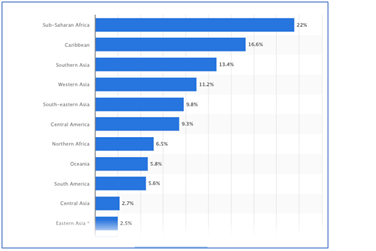
Figure: 1 Percentage of people who are undernourished globally in the period 2019, by region
(Source:Statista ,2020).
Millions of people have been suffering from malnutrition and there has been in fact, 1.9 billion adults who are obese while 462 millions have been underweight. In South Asia, around one in every ten children are being born with a very low birth weight and one out of four deaths amongst the children who are aged under five can be linked to malnutrition (Statista ,2020).
Malnutrition can be considered as an outcome of the dysfunctional interactions occurring between the various systems such as argi-food system, health system, environment system along with the household and individual decision making. Hence, it is directly linked with the global food system in every aspects.
As per the UNO sustainable development goals, goal 2 targets towards “ zero hunger” giving an attention towards how the food can be grown , shared as well as consumed and if it is being done right, forestry, nutritious food , fisheries can help provide food for everyone and generate a sustainable amount of income and even support an enhanced rural development along with the protection of the environment (fao.org,2020).
The goal even states about more and more investment in agriculture that can initiate better productivity and even support a sustainable food system that can help mitigate the hunger issues and associated malnutrition challenges. This has been one of the most prominent food policies in recent times. Moreover, the UNO development goals also aims towards reduced inequalities (goal 10) wherein in order to reduce inequalities, policies needs to be universal in principle and attention has to be paid towards the needs of the marginalised and the disadvantaged population(fao.org,2020). Considering this, the global food system also needs to upgraded so that the issues such as inequal distribution of food which leads to undernourishment and malnutrition can be mitigated well.
2018 for an example, has been an unpredictable year for food and nutrition security and even for the international development and global political stability. Here have been number of regions that faced a growing rate of stagnation and hunger for tackling malnutrition. There have been trade protectionism as well as anti-globalism and even the foreign direct investment in agriculture and food suffered. The rural people all around the globe suffered greater crisis and food insecurity(globalnutritionreport.org,2020).Thus, the world needed to attain the SDG(Sustainable development goals) so that the food and agricultural system can be transformed and the Global Food Policy thus highlights on rural revitalisation to diminish issues such as malnutrition and stimulate economic growth.
The global food trends has been slowly and steadily moving towards waste free and sustainable products that can not only save the environment but also ensures that the health of an individual is duly taken care of. The intake of fresh, organic and healthy food have become the norm of the day and this has been capturing the market at an alarming rate(globalnutritionreport.org,2020) However, the worst part has been that this trend can be considered only for fewer populations especially for the developed countries and for that section of the population who can afford to buy fresh and organic food. But the majority of the population especially in the under develop or developing countries the distribution and concentration of food insecurity has been so high, that contrary to the food trend, which talks about reduction of wastage, people are undernourished and malnutrition.
The contribution as well as food insecurity distribution differs across different regions of the world and thus going by this insecurity the food trend also differs.
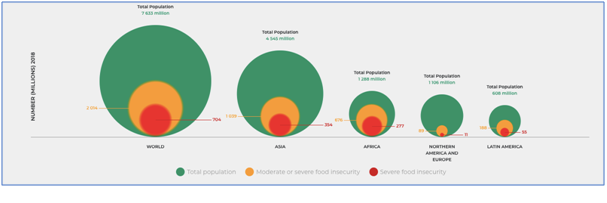
Figure 2: Contribution as well as food insecurity distribution differs across different regions of the world
(Source: who.int, 2017).
As far as health datais concerned, estimation shows that one in seven births or more precisely 20.5 million babies around the world has been suffering from low birthweight as on the 2015.
If this trend continues, the 2025 target of the World Health Assembly that aims towards a 30% reduction in the low birthweight will not be met.
In the year 2018, Asia and Africa has been estimated to have the highest prevalence of exclusive breastfeeding but conversely in these two regions, the prevalence of the women of reproductive age who were anaemic and undernourished also have been higher. Globally , stunting of the children under the age of five however has been decreasing as it has reduced from 165.8 million as on 2012 to 148.9 as on 2018 (Ritchie et al., 2018).
However a deeper look on the SDG indicators related to stunting, wasting will show that in Africa and Asia, there have been greatest share of malnutrition wherein there are nine out of ten of the children who are stunted (Steiner et al., 2019).
The progress on malnutrition therefore has been slow for achieving the 2025 and 2030 global nutrition targets:
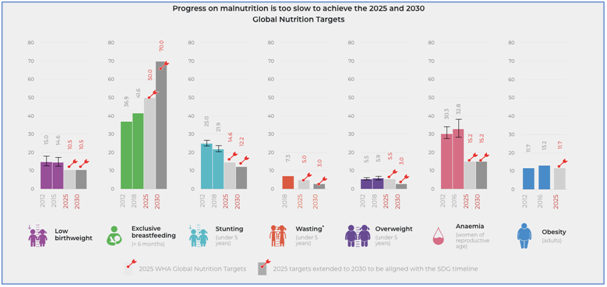
Figure 3: Slow progress related to malnutrition
(Source:Ritchie et al., 2018).
The below figure shows the coexistence of wasting, stunting as well as overweight among the children which has been due to the inequal distribution of food and the incapacity of the countries to reduce the issues associated with hunger .
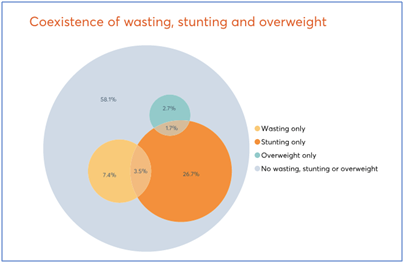
Figure4: Coexistence of stunting, wasting and overweight
(Source: Troell et al., 2014)
Moreover, as per the global hunger index, it can be seen how the South Asian and African South of the Sahara have the highest GHI scores that not only indicates their poor food system but even can give an idea of the number of the population suffering from malnutrition and undernourishment.
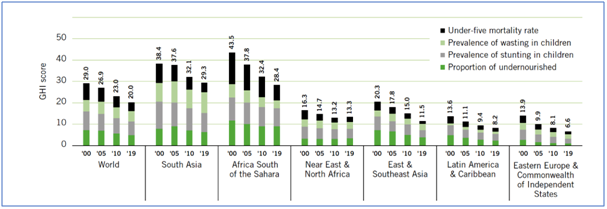
Figure 5 : GHI scores around the world
(Source:globalhungerindex.org ,2020)
There can be number of recommendations that can be given in order to ensure that this public health issue related to the global food system can be altered. Firstly, there needs to be adequate provision of nutrients that can be started with an exclusive breastfeeding until six months and for this the women of reproductive age must have an adequate intake of food and a heathy and highly nutritious diet. It is necessary to reduce the marketing of the various unhealthy processed food and instead ensure that each and every individual receives the nutritious food.
The World Health Organisation needs to work more vehemently with the partners and stakeholders for assisting the countries design and even implement as well as monitor effective plans and strategies.
The governments of the underdeveloped and the developing countries need to ensure that the distribution of food is equal among all, since this plays a very big role in diminishing malnutrition and even ensure that each of the individuals receive the right amount of calories as per their body demands (Von Braun, 2010)
It is important to consider an appropriate public health theory to understand why the people do or do not practice the behaviours related to health promotion. In this context the Health Belief Model can be taken under consideration. This model is used mainly in promotion of health in order to explain maintenance and change of the behaviours related to health and even as a guiding framework for the health behaviour interventions. The HBM states how the health behaviours are determined by the perceptions and beliefs related to health condition and diseases and the various strategies that can help decrease the occurrence. It even incorporates several concepts related to perceived susceptibility, benefit, severity and so on that can predict why does people will be taking action for preventing and controlling the illness condition (globalhungerindex.org ,2020)
Thus, for an example in order to reduce the high burden of children and maternal undernutrition, the model can help in reducing the current barriers and mitigate the adverse effects. People can even change attitudes and ensure a nutrition based education based on this model for betterment of the health condition of the people (Popkin et al., 2020).
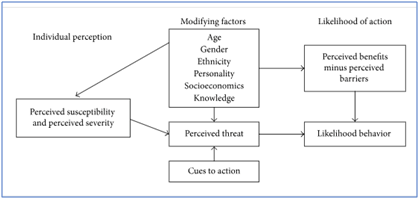
Figure 6: HBM model linkages and components
(Source: Conijn et al., 2018)
Currently the UNO sustainable development goals( goal 2 and Goal 10) aim towards diminishing hunger and reduce inequality and such policy although has been endeavouring to influence the current food system but there seems to have few loopholes that needs to be addressed. The sustainable development involves number of stakeholders who are operating at different scales right from the national governments to the transnational corporations along with the local and international NGO’s and even to the small rural areas. It can be however not easy to receive the relevant stakeholders who have been working together at the right place and time in order to solve the issues of inequality, hunger and malnutrition. For an example, when considering the Goal 2 of SDG, it is important to consider who will be there to develop food supply and agricultural productivity, who will determine what is affordable and reliable and how does the government , countries and the private sectors interact for curbing the hunger issues and how can this be varying under different context. For an example the number of malnutrition people will not be same in the counties across Africa as compared to United States (Popkin, 2017).
Moreover, the policies can even involve certain trade-offs and it is important to recognise all the difficult choices. For an example, food security can be threatened if the crops for food are being switched to biofuel production for security of energy which is another development goal of the UNO. The water security even gets threatened if the decision to intensifyagriculture for better food system and eradication of malnutrition is deeply focused upon. Another key challenge has been ensuring the accountability and responsibility for the advancement towards the developmental goals(Ritchie et al., 2018)
The stakeholders who are involved in the global food system i.e.: the government, the people and the different organisations involved in production of food and so on must address the issue of malnutrition in the following manner:
- Ensure that the governments in all those countries wherein undernourishment is a major issue makes proper nutritional planning and involve a nutritional policy so that there is an improvement in prosecution as well as supply of food.
- There needs to be proper health benefit programmes and various educational programmes especially to educate the people in the rural areas.
- There needs to be equal distribution of food and this can be ensured with enhanced investment on agricultural production so that even there is harvest failure, people can get the nominal food amount for nourishment.
Conclusion
The study as focussed on how the availability and the supply of the food has been a significant factor in shaping the development, emergence as well as persistence of the human civilisation throughout the ages, although there have been number of discrepancies related to it.
The study shows how food although has been much more cheaper in real terms and even much more readily available than at any time in the global food history , but due to its inequal distribution it has been developing health issues such as malnutrition and undernourishment.
References List
Conijn, J.G., Bindraban, P.S., Schröder, J.J. and Jongschaap, R.E.E., 2018. Can our global food system meet food demand within planetary boundaries. Agriculture, Ecosystems & Environment, 251, pp.244-256.
fao.org(2020). SOFI 2019 - The State of Food Security and Nutrition in the World.Available at: http://www.fao.org/state-of-food-security-nutrition (Accessed: 28 September 2020).
globalhungerindex.org (2020). 2019 Global Hunger Index Results - Global, Regional, and National Trends. Available at: https://www.globalhungerindex.org/results.html (Accessed: 28 September 2020).
globalnutritionreport.org(2020). Country Nutrition Profiles - Global Nutrition Report. Available at: https://globalnutritionreport.org/resources/nutrition-profiles/ (Accessed: 28 September 2020).
Popkin, B.M., 2017. Relationship between shifts in food system dynamics and acceleration of the global nutrition transition. Nutrition reviews, 75(2), pp.73-82.
Popkin, B.M., Corvalan, C. and Grummer-Strawn, L.M., 2020. Dynamics of the double burden of malnutrition and the changing nutrition reality. The Lancet, 395(10217), pp.65-74.
Ritchie, H., Reay, D.S. and Higgins, P., 2018. Beyond calories: a holistic assessment of the global food system. Frontiers in Sustainable Food Systems, 2, p.57.Statista (2020). Malnutrition: worldwide share of people by region 2019 | Available at: https://www.statista.com/statistics/273291/number-of-people-with-malnutrition-worldwide/ (Accessed: 28 September 2020).
Steiner, G., Geissler, B. and Schernhammer, E.S., 2019. Hunger and obesity as symptoms of non-sustainable food systems and malnutrition. Applied Sciences, 9(6), p.1062.
Troell, M., Naylor, R.L., Metian, M., Beveridge, M., Tyedmers, P.H., Folke, C., Arrow, K.J., Barrett, S., Crépin, A.S., Ehrlich, P.R. and Gren, Å., 2014. Does aquaculture add resilience to the global food system. Proceedings of the National Academy of Sciences, 111(37), pp.13257-13263.
Von Braun, J., 2010. Strategic body needed to beat food crises: the system that oversees global agriculture and food security needs an overhaul. Nature, 465(7298), pp.548-550.
who.int(2020). Malnutrition is a world health crisis. Available at: https://www.who.int/nutrition/topics/world-food-day-2019-malnutrition-world-health-crisis/en/ (Accessed: 28 September 2020).
www.who.int(2017). Reducing the double burden of malnutrition. Available at: https://www.who.int/westernpacific/activities/reducing-the-double-burden-of-malnutrition (Accessed: 28 September 2020).
The below conceptual framework that has been pioneered by UNICEF has highlighted the drivers of the nutritional status at various levels and the different forms of sectoral respenses that are needed to prevent this health issue.
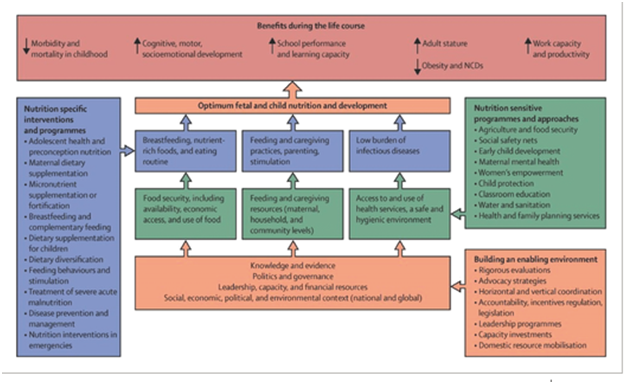
Figure: A framework to achieve the optimum child and fetal nutritional development












